9 roadside repairs that tested my DIY limits
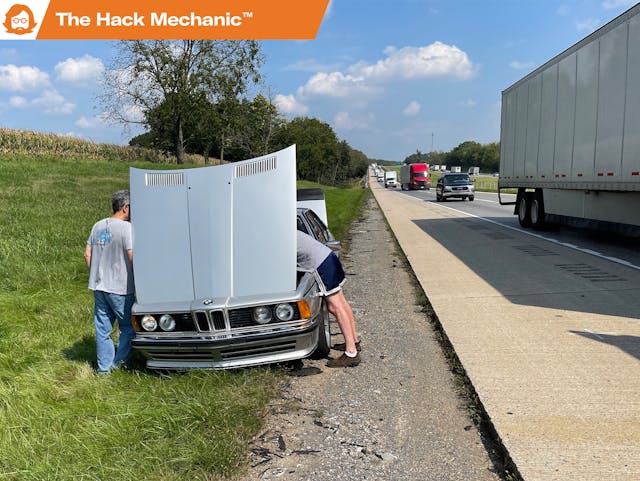
If you’re tooling around close to home in a vintage car, breakdowns aren’t really that big of a deal. Your Hagerty or AAA coverage will probably tow the car home for free or close enough, and you can fix it there. But if you’re road-tripping a car, breakdowns are a much bigger deal. Even if the cause is something you think you can fix, you really don’t want to be in a situation where you need to be under a car when trucks are whipping past only 10 feet away. Anything you know is wrong with a car that is likely to put it in the breakdown lane really should be fixed before a trip.
That having been said, breakdowns happen, and when the cause is obvious and easily addressable, roadside repairs get made. To be clear, whenever possible, don’t literally repair it roadside—if you’re on the highway, limp the car to an exit and find a parking lot instead. Cooling system and oil pressure issues, however, carry a special urgency, as failure to act immediately can result in a cracked head or a lunched engine.
When a roadside repair is ingenious or difficult, it turns into the stuff of legend. I’ve heard stories about broken fan belts in Volkswagens being addressed (or undressed) by convincing a female companion to surrender her panty hose and fashioning a belt out of it (likely a relationship-cementing or a relationship-ending event). One South African friend told me a story about engine failure in a remote area and a weeks-long process of walking miles and hitchhiking while carrying a cylinder head to and from a machine shop. And I witnessed two good friends of mine replace a BMW 2002’s blown head gasket in a hotel parking lot in under an hour and a half.
Now, nothing I’ve done approaches these feats. But after 47 years of wrenching, these are the roadside repairs that stand out above the usual wiring-up of hanging exhausts, reseated distributor caps, “your alternator won’t charge without excitation current from the battery warning light” fixes, and getting a car to start by tapping on the positive battery clamp, the starter, or the electric fuel pump, then going “Ayyyy” like Fonzie.
1. Water pump failure in the Triumph GT6+
In high school, I had been a bicycle guy—riding bikes, fixing bikes, pulling bikes out of the trash and rejuvenating them with parts from other bikes. The summer before college, I was planning on cycling cross-country, which scared the bejesus out of my mother. She blatantly bribed me by offering to buy me a car. I took the bribe and bought the then-six-year-old 1970 Triumph GT6+, easily the worst car I’ve ever owned.
The first of many failures occurred when the car overheated in the hill country north of Amherst, Massachusetts. I limped it to that night’s destination, a friend’s father’s house. I didn’t know much about cars, but knowing bikes, to me the car was just another mechanical system. I could see that the part where water was streaming out had a pulley and a belt on it, and deduced that it was the water pump. I made a few phone calls, found a shop in nearby Hadley that had one, hitchhiked there, and bought it … and the gasket … and the sealant … and the antifreeze.
My friend’s father had enough tools for me to do the job. I had my first taste of the joy of getting myself out of trouble. There were other more devastating mechanical failures to come, and of course the requisite Lucas electrical system problems, but if anything is ground zero for me becoming The Hack Mechanic, it was this.

2. Points closing up in the VW Bus
In early January 1982, my then-girlfriend and now-wife Maire Anne and I moved from Boston down to Austin, Texas, in her rotted 1971 VW Bus with no heat. After surviving an ice storm in Pennsylvania, we finally made it to warmer climes, but somewhere in Arkansas, the bus lost power and sputtered into the breakdown lane. As the de-facto mechanic of my girlfriend’s car, I’d read John Muir’s classic How to Keep Your Volkswagen Alive: A Manual of Step-By-Step Procedures for the Compleat Idiot cover-to-cover. This was my first “it’s almost always the points” experience—due to pitting on the point faces and wear in the little nylon block that runs on the distributor shaft, the point gap had closed up until it no longer triggered the coil. I pulled the points, filed them, did the trick of gapping them with a matchbook cover (which is about the 0.016-inch needed), and voila. I think this is why Maire Anne later married me.
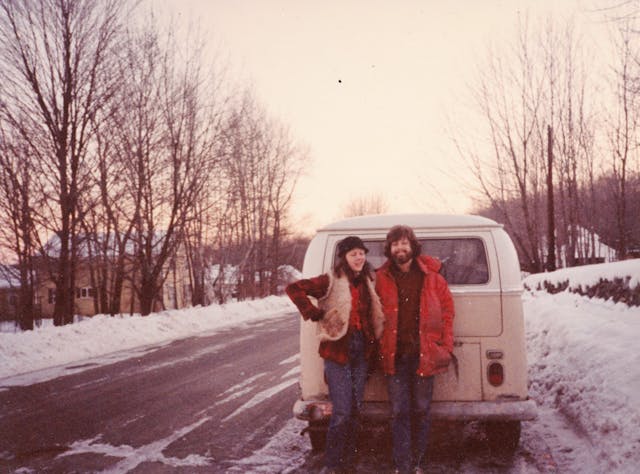
3. Fixing the 2800CS in the middle of a busy intersection
In 1988, I looked at two BMW 2800CS E9 coupes from a salvage yard north of Boston. One was a wrecked picked-over parts car, but the other surprised me by being rusty but whole, and starting and running. I bought them and decided to drive the good one home, use it as a winter beater, and part it out the following spring (I had two other E9 coupes). A few days later, Maire Anne drove me over to the junkyard in our 1983 Volvo 245GLT wagon. I slapped a plate from my daily driver on the 2800CS, jump-started its doornail-dead battery with the Volvo (incredibly foolish—I should’ve brought a fully-charged battery from another car instead), verified that no fluid was gushing out from under the engine compartment, and off we went. Through traffic. At rush hour. Ah, youth. When I was trying to get through the very busy intersection of Rt. 28 and Memorial Drive, I didn’t feed enough gas coming off the clutch, and the car stalled. Since the battery was dead, there was no re-starting it.
So, there I am in the middle of a city intersection at rush hour in a dead, rusty, uninsured, unregistered old car that looked like Beatrix Kiddo in Kill Bill II when she escaped from being buried alive. With it nearly impossible to position the Volvo nose-to-nose to the 2800CS to jump it, I motioned Maire Anne to drive the Volvo to the curb. I ran over, popped open the Volvo’s hood, yanked out its battery (also foolish, as doing so on a running car risks blowing the diodes in the alternator, but necessary), wrapped the positive battery cable in a glove so it wouldn’t short to ground, said to Maire Anne, “Whatever you do, don’t stall,” ran into the intersection with the Volvo’s battery, threw it in the 2800, started it, and drove home. Certainly not one of my smarter moves, but a good story.

4. Reconnecting the half-axle on the Vanagon
Before I began my serial relationship with Suburbans, I had Vanagons. They were weird cars but cavernous inside. I think I went through half a dozen of them before we finally bought the Toyota Previa, which also was weird but was more reliable. When I bought the first Vanagon, the clutch was slipping badly. I dropped the engine (very similar to the old VW busses—support it on blocks, unbolt the bumper, unbolt the engine, roll the bus forward) and replaced the clutch. A few days later, my sister needed to borrow the Vanagon to pick up a piece of furniture. That afternoon, I got a call from her from a payphone (this was pre-cell-phone days) saying that the Vanagon began making a loud rumble, then very loud whacking sounds came from the back.
She and the car were a few miles away. I shot over there with my tools and found that one end of one of the half-axles was flopping in the breeze. Apparently I hadn’t torqued down the ring of Allen-head bolts holding it to the flange on the transaxle. I crawled under the car, tightened things up, and sent my sister on her way. Some 35 years later, she will still sometimes needle me, “Remember when the axle fell off the Vanagon you leant me?” I, of course, will correct her and say, “It wasn’t ‘the axle.’ It was one of the half-axles. And it didn’t fall off—one end just got loose. And I came immediately and tightened it back up, didn’t I?” The funny thing is that, looking back on it, I can’t remember why I had to detach the half-axles at all. Maybe there was some reason why I needed to pull the engine and transaxle together.
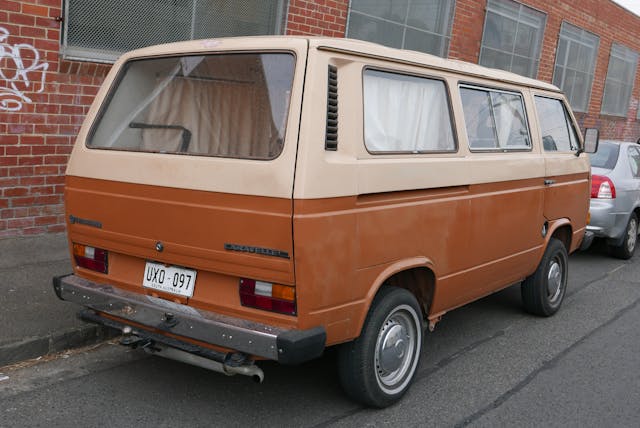
5. Unadjustable fan belt on a 635CSi
I had a 1985 BMW 635CSi that had been gifted to me by my son’s girlfriend’s father. He was mainly a Mercedes guy, and his Mercedes mechanic couldn’t figure out why the 635 wouldn’t start. It turned out to simply be a bad distributor cap. That, an air flow meter, and new injectors got the car running well, but it was by no means well-sorted, and the young man who bought it from me surprised by saying that he wanted to join my convoy on the 2000-mile round trip to The Vintage in Asheville. I warned him that this was risky. He said that he understood that I wasn’t his traveling mechanic, but I couldn’t help but feel a sense of responsibility for both him and the car. Sure enough, on the drive down, the car’s temperature began creeping up and eventually headed for the red zone.
We took the next exit. I found that the belt was slipping even though there was no audible squealing, and the slippage resulted in the water pump not continuously spinning. I tried to adjust the belt, but the bolt in the adjuster track was at the end of the slot, indicating either that the belt was wrong to begin with or had stretched. I was afraid that, if he drove the car hot, he’d crack the head, and I was about to search for the nearest auto parts store when I noticed that next door to the convenience store we’d pulled into was a machine shop where we were able to borrow a round file. I removed the bracket, and Jordan (“the kid”) did the hard work extending the adjustment slot (hey, it was his car). It worked like a charm. We later found a shorter belt, but never needed to install it.
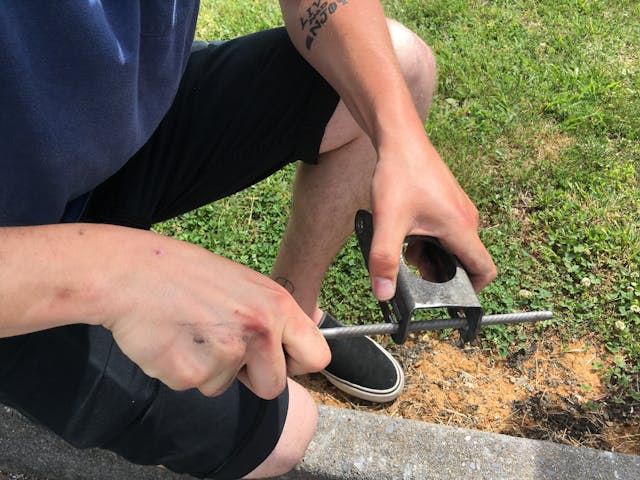
6. Cracked fan on a Euro 635CSi
I was driving my ’79 Euro 635CSi on the return trip from The Vintage—the same trip where I fixed the kid’s unadjustable fan belt. During a rest stop, I opened up the hood to check the oil and was stunned to see that two blades had flown off the belt-driven cooling fan. The 635CSi’s six-cylinder M30 engine was used in BMWs from 1968 through ’95, but it went through three different water pump, fan clutch, and fan configurations, and new parts are no longer available for anything other than the final configuration. I put out the call to friends on Facebook, but unless someone had an old fan, I’d need to replace not just the fan but also update the water pump, the fan clutch, and the pulley.
I removed the fan lest it lose another blade and slice open a coolant hose. This required removing the radiator, which in turn required dumping the coolant. Fortunately I was able to send one of my road trip companions to a nearby Autozone for a catch basin and a few gallons of antifreeze. Driving without a belt-driven cooling fan is usually fine when cruising at highway speeds, but if there’s not enough air flow over the radiator at low speeds or in traffic, it can send temperatures into the red and crack the head. I made a quick wiring mod that allowed me to run the electric pusher fan that’s in front of the A/C condenser without turning on the A/C, and let the car idle in the parking lot to test it. The temperature seemed to top out at about 3/4 of the way up the gauge, so I felt pretty good about making a run for it.
In the meantime, a friend about 150 miles north and on the way home messaged me that he had every part to do the full water pump/clutch/fan/pulley upgrade. We made it to his garage without incident, where I installed the newer-style cooling components. The car’s cooling system was fine until…

7. Leaky heater hose on the same car
A few years later, again on the way to The Vintage and driving the same ’79 Euro 635CSi, I had another cooling system issue. The irony was that, having experienced cooling system issues the last time I road-tripped the car, I wanted to be certain everything was copasetic, so I inspected the cooling system. I found a heater hose that was obviously ballooned and soft. The hose was listed as no longer available from BMW, but I found one as new old stock (NOS) on eBay. I clicked and bought it, but wasn’t certain it would arrive in time, so I hunted around on my parts shelves for a replacement. I found what appeared to be a perfectly good used heater hose. It was clearly better than the ballooned one in the car, so I installed it.
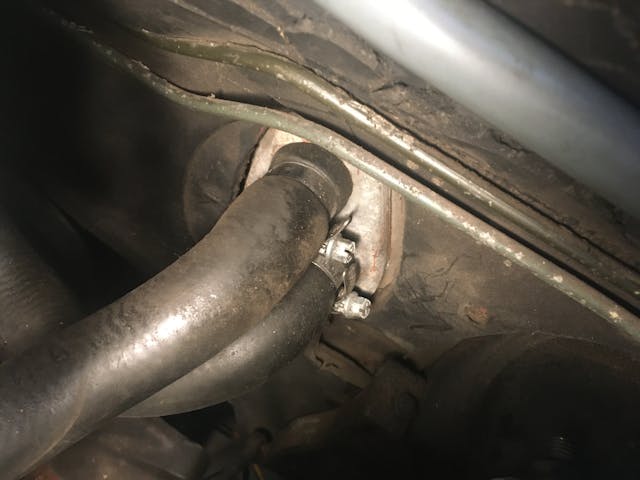
When the NOS hose arrived, I tossed it in the trunk as a spare. On the way to The Vintage, the car’s temp crept up, but did so slowly enough that I thought it was just due to the outside temperature increasing as we headed south, combined with the car rolling up and down the Blue Ridge mountains, but when it tickled the red, I pulled over. I-81 is one of the most heavily trucked routes in the country, so I made it a point to get the car as far off the breakdown lane as I could. Sure enough, the engine was peeing coolant … out the hose I’d just replaced.

Fortunately, I had the NOS hose in the trunk. While I was waiting for the engine to cool down, I sent my travel companions for antifreeze, at which we all had a serious déjà vu, as the same thing happened with the car and the same people three years prior. It was yet another reminder how much easier these things are when you’re not trying to act like a lone wolf.
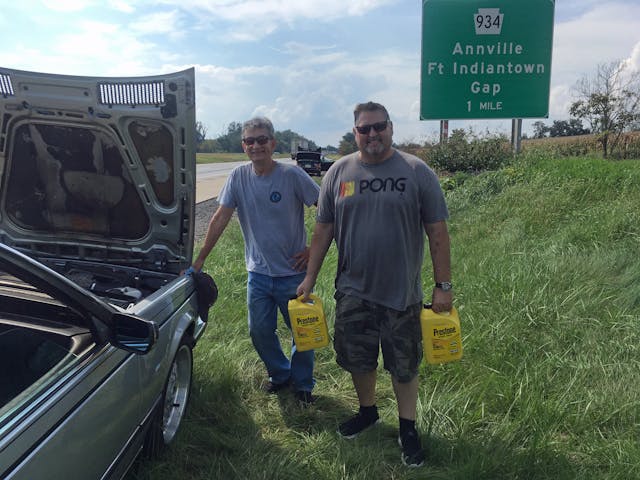
8. High beam stalk disintegrates on the Merritt Parkway
The Merritt Parkway is a windy two-lane road north of New York City with a lot of elevation changes. When I was younger, I used to love the Merritt for that reason, but in my dotage I find it stressful due to the 85-mph traffic, the sudden squeezing of two lanes down to one due to construction, the lack of illumination at night, and the repeated experience of coming over one of the rises and having to jam on the brakes due to the sudden sea of red lights. As such, I usually avoid it, but sometimes I’ll just do whatever Waze says, and if it takes me via the Merritt, so be it. Such was the case on one of my trips to The Vintage in a 2002tii.
It was night. Traffic was light to moderate, so there was a lot of toggling the stalk between low and high beams. During one such flick, the stalk fell apart in my hand. What’s the big deal, you might say? Did it fail in the low or high beam position? That was the problem. Neither—my headlights went completely out. With the Merritt Parkway’s lack of lighting, I was abruptly plunged into darkness. I slowed down while fumbling with the stalk to see if I could restore lighting. Fortunately I found one fragile position where the lights came back on, but they went out if I deviated in the slightest. I drove very carefully that way—one hand on the wheel, the other on the stalk—until I came to a rest area. On road trips, I always pack a roll of wire, a variety of connectors, and a crimping tool, so I had no question that, if necessary, I would wire the lights directly to the fuse box, but I thought that I’d first try fixing the stalk. I took the upper and lower panels off the steering column to expose the stalks and found that the potted metal tabs holding the Bakelite back of the stalk in place had broken off.
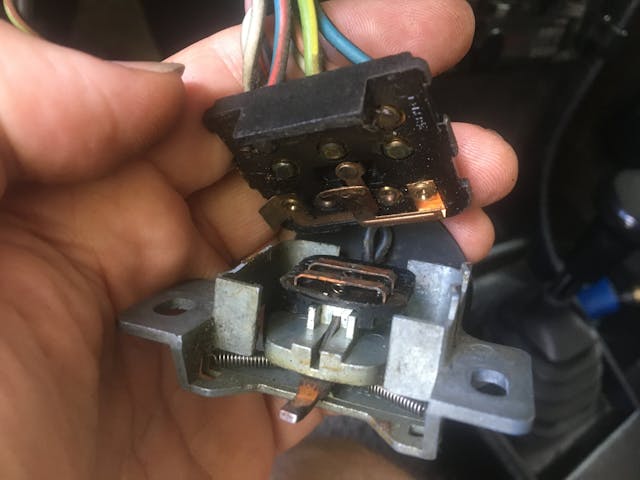
I carefully put the stalk back together, held it together with zip ties, re-attached it, and tested it. It held. For the rest of the trip, I flicked the stalk very carefully lest it fall apart again, but it’s now eight years later, and those zip ties are still in place.
9. J-B Welding a cracked head
I’d say that I’m saving the best for last, but I already wrote about the time that I J-B Welded a cracked cylinder head in a lot of detail here. It almost doesn’t count as a roadside repair, as it didn’t technically fail on the road, and as it certainly wasn’t fixed roadside—I was in a first-class repair shop with the advice of a seen-it-all mechanic—but it was still enormously satisfying to stop the dripping of oil out a crack at the top of the head onto the exhaust manifold using J-B Weld and be driving home a few hours later.

How about you folks? What was your favorite roadside repair? Wipers pulled back and forth with rope? Throttle controlled with a hand-yanked cable? Tell me what you’ve got.
***
Rob’s latest book, The Best Of The Hack Mechanic™: 35 years of hacks, kluges, and assorted automotive mayhem is available on Amazon here. His other seven books are available here on Amazon, or you can order personally-inscribed copies from Rob’s website, www.robsiegel.com.
Check out the Hagerty Media homepage so you don’t miss a single story, or better yet, bookmark it. To get our best stories delivered right to your inbox, subscribe to our newsletters.


First off most repairs can be avoided if you keep up on things.
Second if on a freeway do not do a repair there. Get off or call a tow truck. Many people are hit on the freeway.
Be considerate where you do a repair and what you are doing. We have had people try to change transmission in the parking lot at work. That is not a good idea for the mess you make and often the tools you lack.
If in a good place keep things reasonable.
I lost a hose on a new car years ago at a mall. It was Saturday at 6:30 PM. I was able to buy a hot dog and lottery ticket at the gas stations but no hoses. I finally recalled a Sear Service center about a mile away. I took the hose off as it was the upper. Walked to the service center and found they did not list the hose. I asked to look at what they had and found one in the right shape and took a pair of scissors to cut it to length.
Also working at the gas station I have resorted to fixes at peoples homes to get cars in to work to finish the repairs. It is amazing what you can do with a little ingenuity.
I even broke into a Toyota once with a screw driver and a yard stick that one owner locked the keys in.
I had a 1977 International Harvester Loadstar 1600 dump truck, with the 50s looking metal gullwing hood, that I would drive my 4 year old daughter around on the weekends for errands. She loved it. Broke down on the side of the highway due to a fuel issue. It had a new mechanical fuel pump, but it seemed to be vapor locking or something. My cousin brought us a cheap electrical fuel pump and we wired it in near the tank, just letting it push through the mechanical pump. It worked, got us home, and stayed that way without issue for the next year or so until I sold it. My daughter cried as it left our driveway.
I replaced the timing chain on my ’70 Pontiac Lemans in New York’s Coliseum Garage in 1981 while wearing a suit. I took off all my clothes except the pants to save my shirt tie and jacket. Had to borrow some tools from the guys at Motor Magazine in the Hearst building, which was just around the corner and was my place of employ at the time. Took a cab to an auto parts store on 11th Avenue to buy a new chain. Took me most of the day.
Also in a suit, I changed the upper radiator hose on my 1984 Mustang GT in a gas-station lot, in an iffy neighborhood. Happily, the station still had repair facilities (it is now a convenience store), and had the hose in stock – but could not get to the Mustang for a few hours. I borrowed a screwdriver, changed the hose, bought some antifreeze to put in, and made it to work only about an hour late – and rather dirty. I started then carrying a few tools in the car (it was less than ten years old, so I didn’t carry any tools).
My story cannot top your timing chain, though!
I tried to replace the timing chain in my ’67 Chevy Van that left me and my girlfriend stranded overnight on California’s 101 somewhere near King’s City. We slept in the van overnight and greeted by an officer at 7am in the morning. Explaining my story, he was nice enough to drive us to Napa to get a new timing chain and return to the van. Morning turned to afternoon and as the heat of the day wore on, I came to realize the old 250-6 was using a nylon cam gear that was press fit. At that point it became obvious this would not be a roadside fix. The van was towed to a wrecking yard and we spent Saturday and Sunday nights at a Motel 6 waiting for the repair to be done on Monday. I was only 20 and as I aged I got smarter about mechanics and repairs, and also about maintenance so cars wouldn’t break down on me (though many have).
“it’s almost always the points” On my honeymoon in 1973, we were going up Clingmans Dome in the Smokies. Our ’66 Chevy van started losing power, about halfway up a VW Bus passed me. I knew we were in trouble, so at the first opportunity I pulled over, lifted the engine cover (between the seats), pulled the distributor cap and reset the points using the matchbook cover trick. Shortly after we got home, I sold the van, bought a Beetle and John Muir’s book.
My ’53 M38A1 Jeep lost the pitman arm nut whilst crossing a RR track and soon after the bolt. My passenger was a bit stunned when I sawed the wheel back and forth and said “look boss, no steering!” Despite brakes pulling in four different directions we got her stopped and sussed the situation out. I found the bolt but the nut was long gone. Digging through the 3 (4, 5, 6?) storage dumps on the jeep I scored a bit of heater hose and 5/8″ clamp that served as a nut. Tragedy averted; day saved. A second situation was no less harrowing but easier to recover from. I was crossing a busy highway when a loud bang left the jeep to move on its meager momentum and nothing more. Vigorous hand waving got me through the intersection to a safe stop. Diagnosis revealed a lot of noise at the rear end but no motion. I assumed a tanked rear diff and engaged the front axle. Problem solved! I later found that the RH axle shaft had sheared at the differential. The shear was conical and held things in place but could not transmit torque. You learn a lot with an old jeep.
It was 1979, in the near western suburbs of Chicago. The phone rang, it was my wife calling from an accommodating roadside business (personal mobile phones were still the stuff of Popular Science of course). She was holding the shift lever of our 1971 Datsun 510 in her hand, and she was unfortunately not in the car. I grabbed a few tools, jumped into my 1968 Datsun 2000 Roadster, and found the 510 on the side of a busy 4 lane road. The problem was immediately apparent: the aluminum arm that connects the shift lever to the 4-speed linkage had snapped off. I don’t know if it was genius or luck, but one of the tools I had grabbed was a pair of Vice-Grips. It easily clamped onto the remaining stub of the arm, and served as a perfectly usable (if a bit short) surrogate shift lever. We were on our way home in two minutes!
I still have that pair of Vice-Grips, and it has saved my butt many times (usually involving rounded off bolt heads). And of course, one of the first tools I put in my classic car roadside repair kit was a Leatherman tool that includes a small locking plier.
“She was holding the shift lever of our 1971 Datsun 510 in her hand, and she was unfortunately not in the car.”
Reading this one actually made me laugh out loud.
We had a 72 510. Fine car but tended to rust.
I find it interesting all these breakdown’s were on foreign cars.
When I started to read “I still have those vice grips” I thought you were going to say “on the shifter”. lol
The 510 succumbed to the iron oxide gods many years ago, so I could only save the Vice-Grips. Too bad, since 510s have become quite collectible these days!
Did the same shift lever repair on a 1970 Corolla- it was my first stick and I guess I was a bit too enthusiastic changing gears!
My 1981 Jeep CJ-8 has a V8 conversion that required a compound radiator hose utilizing a barbed connector. Unfortunately, I chose to use a plastic connector that decided to split at 11,000 feet on an old mining road above Silverton, Colorado. Because this area is littered with old mining equipment from the 1880s, I was able to find a rusty but still usable iron nipple from an old boiler to replace the connector and get things running again. Using hardware from the 1800s for the repair made my 40 year-old jeep seem positively modern!
Very cool.
Rob great compulsion of multiple short stories. My only roadside adventure was my AC Compressor clutch locked up on my 78 Eldorado Custom Biarritz on the interstate south east of T Town and snapped the belt. The only issue was the brilliant engineers at GM had the same belt driving the power steering pump. So you think no AC no power steering, well it was not that simple, as the power steering pump powered the power brakes. So try driving a 6,000 lbs front wheel drive coupe with now power steering no power brakes and in Alabama humidity with no AC. In the 1971-1973 Eldorados there were twin belts performing this job but I am sure as a cost cutting measure they reduced it to one. But we made it to T-Town and the fine people at the Cady store in Tuscaloosa had us back on the road the next day with a new AC compressor and clutch and new belts all around. Happy Motoring and Roll Tide….
That’s a pretty good catalog of roadside failures.
I once put rod bearings in my 1971 Datsun 510 in a department store parking lot. Just dropped the pan and switched them out. I don’t remember it being particularly hard but I was a lot younger then.
A most exciting moment for me was winter time in Fairbanks Alaska driving a 1978 Plymouth horizon. Must’ve had ice crystals in the gas and carburetor and pedal stuck to the floor wide-open! I could not get it to release and had to shut the key off on occasion, as we were spinning, going, uphill, even with snow tires. An exciting ride to work.
Sounds like you had a ground based version of a Sopwith camel.
Many roadside fixes for me over the years. One that sticks out is radiator flush on rt 80 in PA on way to Mid Ohio in a caravan of Triumph sports cars. It was a TR4-A I had recently gotten running after years of storage. Issue was sunflower seeds a mouse had collected in bottom radiator tank that made it to top blocking flow.
Had to use washer fluid to flush radiator as no hose available. Managed to strain seeds out of coolant and removed thermostat as a precaution. Rest of trip others broke but 4-A motored on.
OK Rob, here you go! This one was so satisfying I filmed it.
https://www.youtube.com/watch?v=VGjIckBUAlM
Danny Plotkin
I once fixed a diesel powered stump grinder that the operator had utilized a bic pen body to repair the supply line to the fuel transfer pump. The guy had cut it short enough and assembled it well enough the only clue it was there at all was two hose clamps on the fuel line for no apparent reason… It got the job done, he didn’t tell anyone about the repair, and eventually moved on so we had no idea how long the bic plastic made an acceptable union until it didn’t – not by leaking externally but breaking down internally and eventually stopping the fuel flow.
Danny, nice!
Before moving to Germany with my 1977 Datsun 280Z back in the 80’s, I asked my mechanic friend what he might expect to break first while driving at Autobahn speeds. He said I might need a water pump. So I bought one and packed it with the car along with all the tools needed to replace it. Sure enough, on my trip to me new home from the port in north Germany, my water pump failed in the middle of the night. Of course I had the new one with me, but no flashlight other than the tiny under-hood light on the Datsun. Shortly after beginning work (just off the nearest exit.) a German man stopped to see what i was doing. Even though we could not communicate, he pulled out a very large, bright flashlight so I could see what I was doing. He stayed there until I was finished with barely a word spoken between us!
Michael, that’s a beautiful thing. I had a similar thing happen with an old Hispanic gentleman where I used to store my cars in Fitchburg. He witnessed me having trouble starting a months-long stored car and trying to trouble-shoot it with a cell phone, rummaged around in his truck, and came over with a big honkin’ flashlight and held it until I was up and running. The passion that transcends language!
I had a 69 Corvette. Within hours of buying it I was caught in a torrential rain (a regular occurrence in East Texas), hydroplaned and everything went dead. This was before cell phones, so I walked to a pay phone andI called Shawn, who I bought the car from, and he said he knew what was wrong. He came out with a 3 inch piece of wire and replaced the “fuse link connector ” and power was restored. But the car would not start. A friendly DPS office (thanks David) cameby, sprayed WD40 In the distributor cap and it kicked right off.
MANY years ago, I was driving my first car, a 47 Studebaker that we inherited by buying a piece of farmland. I drove it around the farm and got it running okay. Drove it 100 miles home and was driving out to our local drag strip. (to watch I’m not that crazy) On the highway I heard a huge bank and then many follow ups. Inside of car was dust. I pulled over and found a universal joint had lost and end cap. I wandered in the ditch and found a pop can. I managed to tear a strip of alum and wrap it in the u joint in place of the end cap. Made it to the drag strip. I had friends tow me home later.